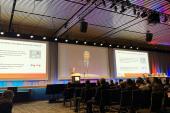CVD Risk Twofold Higher in Patients With Cancer: ASPREE
With patients surviving longer, there is a need to address long-term risks of CVD associated with cancer, say experts.

Cardiovascular risk, including the risk of MI, heart failure (HF), and ischemic stroke, is significantly elevated in older patients diagnosed with cancer, according to a new analysis of the Aspirin in Reducing Events in the Elderly (ASPREE) trial.
The incidence of CVD in those who developed cancer during the study was more than twofold higher than in those who did not develop cancer, and was particularly pronounced in those with metastatic disease, as well as those with hematological and lung cancers.
“Over the last decade or so, the rates of cancer-related deaths have declined and this has led to an increasing number of cancer survivors,” senior investigator Suzanne Orchard, PhD (Monash University, Melbourne, Australia), told TCTMD. “We've been looking at the consequences of a cancer diagnosis and its treatment in all aspects of health, but with cardiac health specifically, studies are showing that there is an increased risk in cardiovascular disease in our cancer survivors. It’s an important area to address in terms of how we're going to manage or mitigate these risks.”
Ana Barac, MD, PhD (Inova Schar Cancer Institute/Inova Heart and Vascular Institute, Falls Church, VA), who wasn’t involved in the study, said the new analysis, which has several strengths, adds to the growing body of evidence about the connection between the development of cancer and subsequent CVD.
“I think the paradigm has really switched,” she told TCTMD. “This study increases the need for cardiologists to be aware of [the risks] associated with cancer, and vice-versa, [and for] oncologists to recognize the risk of overlapping cardiovascular disease.”
Barac, who was the founding chair of the American College of Cardiology’s Cardio-Oncology Council, said that oncologists used to be wary of sending patients to cardiologists as heart problems may preclude patients from receiving certain cancer therapies. Now, if a newly diagnosed cancer patient has risk factors or overt CVD, they need to be optimally managed and treated by both specialties.
“There should be a partnership between cardiology and oncology in any institution so that there’s increased awareness,” she said. “We shouldn’t withhold oncology therapy, which is needed, but we need to be proactive about [looking] for heart failure before it develops because once it develops, it’s a little too late.”
The study, which includes first author Jaidyn Muhandiramge, MD (Monash University), was published September 23, 2024, in Cancer.
Link Seen in Other Studies, Too
Several large observational studies published to date have shown there is a higher incidence of coronary heart disease, HF, and stroke in those diagnosed with cancer. The risks decline with time but can remain significantly elevated for several years after the cancer diagnosis. The diseases share similar risk factors, such as smoking and sedentary behavior, “but cancer and cancer treatment-related mechanisms, including inflammation and treatment-related cardiotoxicity, may also contribute,” according to the researchers.
In ASPREE, which was published in 2018, investigators showed that aspirin 100 mg failed to lower the risk of major CVD events in nearly 20,000 community-dwelling older adults without preexisting disease. This new analysis focuses on 15,454 participants (mean age 74 years; 58% female) no cancer at baseline. During the follow-up period, 9% of people enrolled developed cancer without preceding CVD.
The most common cancer types were prostate (26%), colorectal (14%), breast (12%), hematological (11%), lung (8%), and melanoma (8%). The most common metastatic cancers were lung (20%), prostate (18%), and colorectal (15%). For those diagnosed with cancer, 82% were treated, with surgery the most common option (55%) followed by systemic therapy (45%) and radiation (29%).
The rate of CVD (a composite of MI, hospitalization for HF, and stroke) was twofold higher in those with a cancer diagnosis than in those without cancer (incidence rate ratio [IRR] 2.03; 95% CI 1.51-2.66) after adjusting for age, sex, smoking status, hypertension, chronic kidney disease, and aspirin treatment. Risks were significantly higher for HF and stroke, with a trend toward more MIs in cancer patients. The risk of CVD was highest soon after the cancer diagnosis and stayed elevated relative to those without cancer for the 4-year follow-up period.
The overall risks of CVD line up with prior observational studies, said Orchard, but the ASPREE dataset also allowed researchers to assess whether more advanced cancers had higher risks. Those with metastatic cancer had a fivefold higher risk of CVD compared with those without cancer (IRR 5.21; 95% CI 2.78-8.79), while no increased risk was seen in those with non-metastatic cancer. In terms of cancer types, hematologic and lung cancer were both linked with roughly a three- and fivefold higher risk of CVD.
“It’s sort of not surprising given that those with more advanced [metastatic] disease, of course, have a higher impact of their cancer,” said Orchard. “They will likely have undergone stronger treatment regimes and will have probably experienced more cancer-related deconditioning. So, it’s not surprising that their risk was high, but nonetheless, we were surprised at just how high that risk was in this particular group.”
Both aspirin- and placebo-treated patients with cancer had higher risks of CVD during follow-up.
Regarding treatment, surgery was associated with a decreased risk of CVD, but the results were inconclusive with respect to risks posed by other treatments. There was a trend toward higher CVD risks with systemic therapy, as well as a higher risk of MI and HF with radiation. In this analysis, only use of cytotoxic chemotherapy was associated with a significantly higher risk of CVD in follow-up. Orchard said the analysis was likely underpowered to detect significant differences amongst treatment.
Risk Factors and CHIP
“Usually, studies focus on only one thing, either cardiovascular disease or cancer,” said Barac. Oncology trials with different treatments want only to include patients who are without CVD and/or risk factors, she added, because “every pharmaceutical company wants an Olympian in their cancer trial—they don't want them to have any [other disease] to get onto the trial. Therefore, we often do not learn about the interactions and drug side-effects in [the] real world.”
While the connection between cancer and CVD might be the result of shared risk factors, Barac pointed to the St. Jude Lifetime Cohort Study of survivors of childhood cancer that showed there was an increasing risk of major adverse cardiovascular events if they developed subclinical conditions, such as hypertension, when compared with controls with similar subclinical conditions but who didn’t have prior cancer. Such rigorous, granular data are not available in adult cancer survivors, said Barac.
In addition to risk factors common to both diseases, one shared mechanism that has been hypothesized to explain the link between cancer, particularly hematological malignancies, and CVD could be clonal hematopoiesis of indeterminate potential (CHIP), said Barac. With CHIP, which occurs with aging, there is an increase of hematopoietic stem cells with malignancy-associated somatic mutations. CHIP has been identified as a novel predictor of cardiovascular risk .
“The [ASPREE] findings further support the hypothesis that there could be a link, that there is that susceptibility to cardiovascular disease and certain malignancies, which may not be fully explained by our existing risk factors,” said Barac.
Given the apparent risks, Orchard said that cardiovascular screening should not be limited just to patients undergoing cardiotoxic chemotherapy.
“We know there are measures that can help manage and prevent cardiovascular disease in cancer survivors and these measures include risk factor control,” she said. “You can do cardiac screening both before and during the treatment so you're keeping a careful watch for your patient's response. Also, try to implement some exercise interventions such as swimming and walking. All of these strategies should be implemented for all survivors of cancer, not just those receiving cardiotoxic therapies.”
With respect to the lack of CVD protection afforded by aspirin, Barac isn’t surprised, noting that aspirin is no longer recommended for the primary prevention of CVD. In 2022, on the basis of ASPREE, as well as ARRIVE and ASCEND, the United States Preventive Services Task Force recommended adults 60 years and older not start aspirin for CVD prevention, and said that if used in higher-risk patients aged 40 to 59-years-old, the net benefit of aspirin is very small.
Michael O’Riordan is the Managing Editor for TCTMD. He completed his undergraduate degrees at Queen’s University in Kingston, ON, and…
Read Full BioSources
Muhandiramge J, Zalcberg JR, Warner ET, et al. Cardiovascular disease and stroke following cancer and cancer treatment in older adults. Cancer 2024;Epub ahead of print.
Disclosures
- Muhandiramge, Orchard, and Barac report no conflicts of interest.





Comments